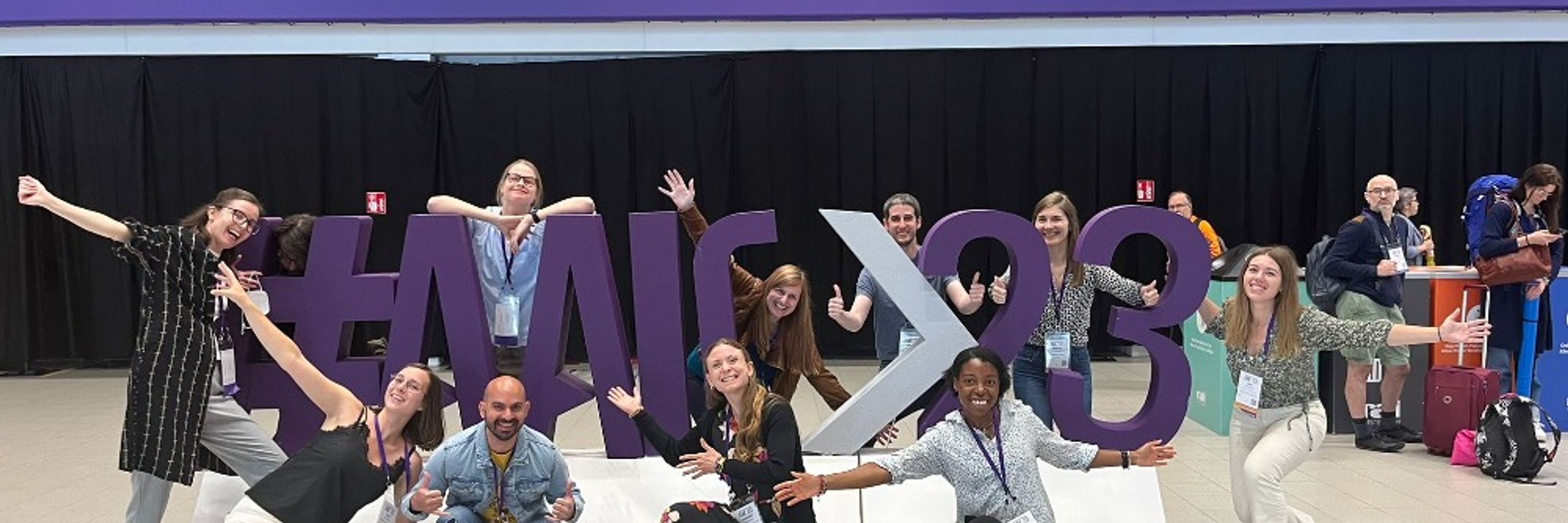
Heidi Jacobs
@heidijacobslab.bsky.social
Associate Prof @MGH @HarvardMed @MaastrichtUni | Locus coeruleus & other neuromodulators in early detection and prevention of Alzheimer’s disease | 7T MRI, PET
Pinned
Heidi Jacobs
@heidijacobslab.bsky.social
· Jul 23

Earlier Detection of Alzheimer’s Could Help Reduce Its Most Devastating Effects
Heidi Jacobs, PhD, is a leader in Alzheimer’s disease research whose personal experience with the disease strengthens her passion for finding a cure — something she is well on her way to achieving.
giving.massgeneral.org
Learn about our work towards earlier detection of Alzheimer's disease. Despite NIH-funding being delayed, terminated, and uncertain, we are fiercely committed to these goals! Link for donations to support our work is at the bottom of the page, or reach out.
giving.massgeneral.org/stories/earl...
giving.massgeneral.org/stories/earl...
Reposted by Heidi Jacobs
⚠️ We are hiring a ✨Postdoc✨in Neuroimaging 🧠
Come work with me in the vibrant city of #Toronto! 🌇 Exciting projects related to #Alzheimers disease & vascular brain injury 👩🏻🔬👨🏽🔬🔬
➡️Apply: tinyurl.com/SRIpostdoc
#NowHiring #STEM #phdlife @sunnybrookhsc.bsky.social
➡️Summary:
Come work with me in the vibrant city of #Toronto! 🌇 Exciting projects related to #Alzheimers disease & vascular brain injury 👩🏻🔬👨🏽🔬🔬
➡️Apply: tinyurl.com/SRIpostdoc
#NowHiring #STEM #phdlife @sunnybrookhsc.bsky.social
➡️Summary:
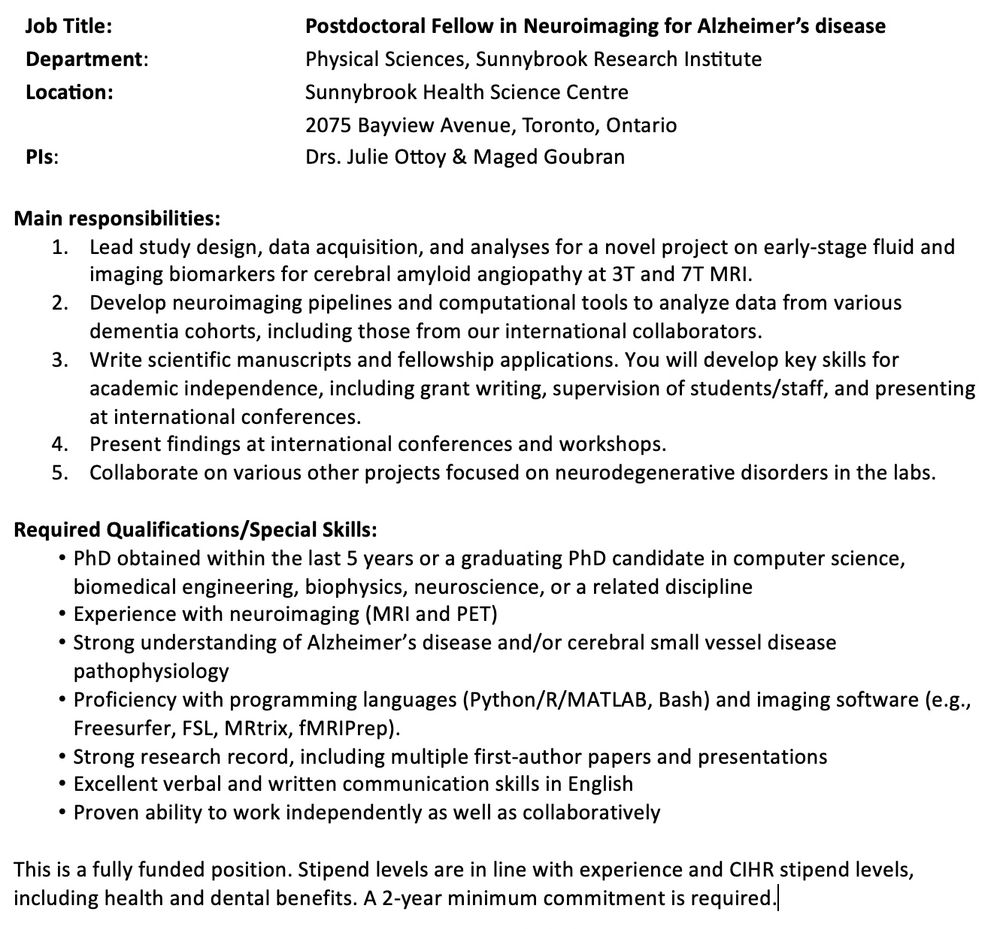
November 9, 2025 at 5:12 PM
⚠️ We are hiring a ✨Postdoc✨in Neuroimaging 🧠
Come work with me in the vibrant city of #Toronto! 🌇 Exciting projects related to #Alzheimers disease & vascular brain injury 👩🏻🔬👨🏽🔬🔬
➡️Apply: tinyurl.com/SRIpostdoc
#NowHiring #STEM #phdlife @sunnybrookhsc.bsky.social
➡️Summary:
Come work with me in the vibrant city of #Toronto! 🌇 Exciting projects related to #Alzheimers disease & vascular brain injury 👩🏻🔬👨🏽🔬🔬
➡️Apply: tinyurl.com/SRIpostdoc
#NowHiring #STEM #phdlife @sunnybrookhsc.bsky.social
➡️Summary:
Reposted by Heidi Jacobs
Just published in Nat. Neurosci.
Led by J.P. Ferrari-Souza, this study used imaging & fluid biomarkers to reveal that microglia modulate Aβ-related astrocyte reactivity, which in turn contributes to AD progression.
@erzimmer.bsky.social
@natureportfolio.nature.com
www.nature.com/articles/s41...
Led by J.P. Ferrari-Souza, this study used imaging & fluid biomarkers to reveal that microglia modulate Aβ-related astrocyte reactivity, which in turn contributes to AD progression.
@erzimmer.bsky.social
@natureportfolio.nature.com
www.nature.com/articles/s41...

Microglia modulate Aβ-dependent astrocyte reactivity in Alzheimer’s disease - Nature Neuroscience
Microglia influence amyloid-β effects on astrocyte reactivity in the living brain of individuals with Alzheimer’s disease. This phenomenon further contributes to cognitive impairment via tau phosphory...
www.nature.com
November 7, 2025 at 10:16 AM
Just published in Nat. Neurosci.
Led by J.P. Ferrari-Souza, this study used imaging & fluid biomarkers to reveal that microglia modulate Aβ-related astrocyte reactivity, which in turn contributes to AD progression.
@erzimmer.bsky.social
@natureportfolio.nature.com
www.nature.com/articles/s41...
Led by J.P. Ferrari-Souza, this study used imaging & fluid biomarkers to reveal that microglia modulate Aβ-related astrocyte reactivity, which in turn contributes to AD progression.
@erzimmer.bsky.social
@natureportfolio.nature.com
www.nature.com/articles/s41...
Reposted by Heidi Jacobs
Our paper and research on a #taVNS #MRI setup has now been published: onlinelibrary.wiley.com/doi/10.1111/...
@nbkroemer.bsky.social @glassybrain.bsky.social
@nbkroemer.bsky.social @glassybrain.bsky.social
#TaVNS inside the MR scanner IS POSSIBLE! ⚡🧠
I hope that this paper and its guidance on the taVNS MRI set-up will help those planning concurrent #fMRI and #vagusnervstimulation
Checkout our new preprint
osf.io/preprints/ps...
Endless gratitude to @nbkroemer.bsky.social & @glassybrain.bsky.social
I hope that this paper and its guidance on the taVNS MRI set-up will help those planning concurrent #fMRI and #vagusnervstimulation
Checkout our new preprint
osf.io/preprints/ps...
Endless gratitude to @nbkroemer.bsky.social & @glassybrain.bsky.social
In our new preprint, we share insights on improvements to the conventional hardware used for concurrent fMRI + vagus nerve stimulation. It attenuates temperature increases and artifacts. #neuroskyence
Led by @glassybrain.bsky.social & @cogneuroludwig.bsky.social.
osf.io/preprints/ps...
Led by @glassybrain.bsky.social & @cogneuroludwig.bsky.social.
osf.io/preprints/ps...
November 7, 2025 at 7:13 AM
Our paper and research on a #taVNS #MRI setup has now been published: onlinelibrary.wiley.com/doi/10.1111/...
@nbkroemer.bsky.social @glassybrain.bsky.social
@nbkroemer.bsky.social @glassybrain.bsky.social
Reposted by Heidi Jacobs
Excited to share our newest project using spatial transcriptomics with novel image analysis approaches to investigate the impact of biological risk factors for Alzheimer's disease (AD) - APOE haplotype, sex, and genomic ancestry - on molecular states in the locus coeruleus (LC 🔵) of the human 🧠.
Got with the times + made a BSky to share our new, large-scale spatial RNAseq study of adult human #locuscoeruleus! Co-1st auth and cryostat wizard @heenadivecha.bsky.social squeezed 85 tissue sections into 43 Visium arrays. (1/8)
www.biorxiv.org/content/10.1...
www.biorxiv.org/content/10.1...
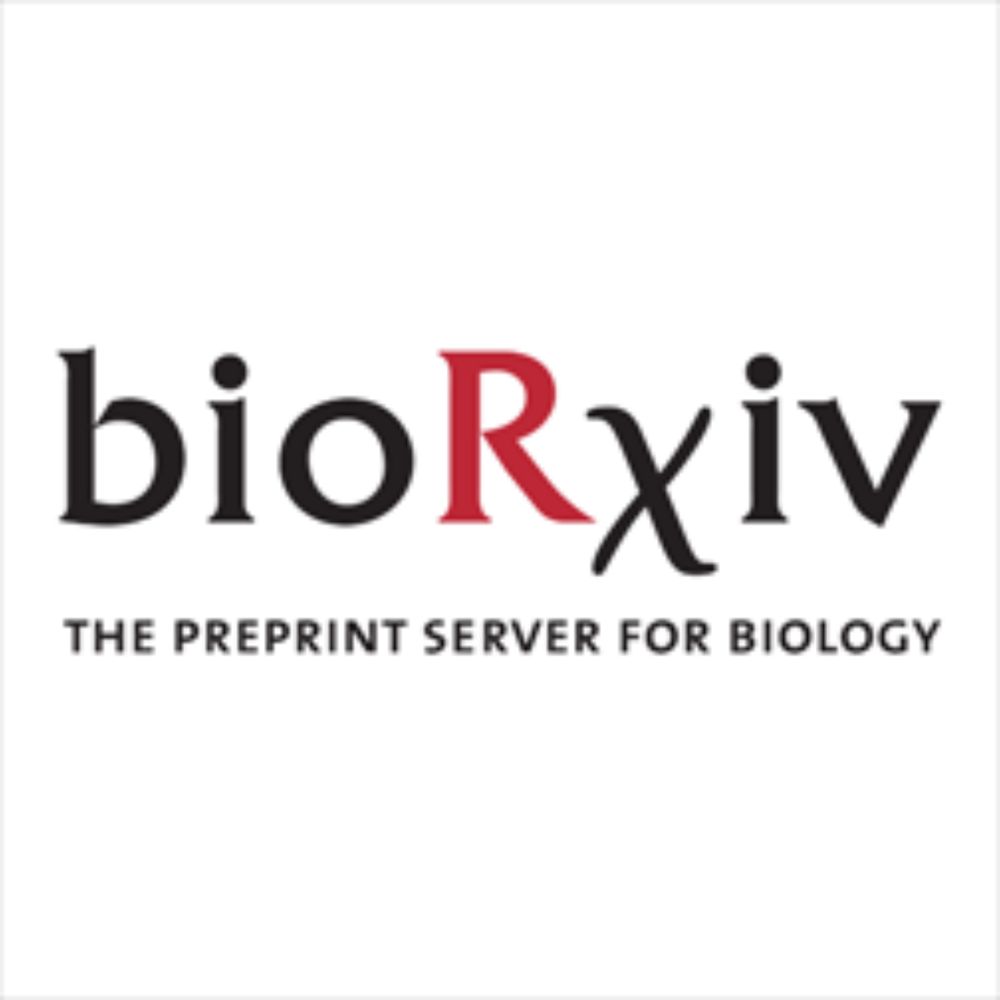
Impact of Alzheimer's disease risk factors and local neuromelanin content on the transcriptomic landscape of the human locus coeruleus
The locus coeruleus (LC) is a small noradrenergic nucleus in the dorsal pons that sends projections across the brain regulating sleep, arousal, attention, stress responses, and some forms of cognition...
www.biorxiv.org
October 31, 2025 at 5:24 PM
Excited to share our newest project using spatial transcriptomics with novel image analysis approaches to investigate the impact of biological risk factors for Alzheimer's disease (AD) - APOE haplotype, sex, and genomic ancestry - on molecular states in the locus coeruleus (LC 🔵) of the human 🧠.
Reposted by Heidi Jacobs
Our paper on CSF, BOLD, pupil, and physiological measures in sleep deprivation and recovery sleep is finally out! 🎉 Congrats Zinong! www.nature.com/articles/s41...

Attentional failures after sleep deprivation are locked to joint neurovascular, pupil and cerebrospinal fluid flow dynamics - Nature Neuroscience
Yang et al. show that moments of failed attention we experience after sleep deprivation reflect brief ‘sleep-like’ episodes in the brain, corresponding to a brain- and body-wide event with altered bra...
www.nature.com
October 29, 2025 at 7:26 PM
Our paper on CSF, BOLD, pupil, and physiological measures in sleep deprivation and recovery sleep is finally out! 🎉 Congrats Zinong! www.nature.com/articles/s41...
Reposted by Heidi Jacobs
New release of PowerLMM.js! Browser-based power analysis for longitudinal models with dropout.
Now includes:
- Power analysis summary report
- Reproducible & shareable configs (URL/JSON)
- Calculations validated against R
- Hypothesis region visualization
powerlmmjs.rpsychologist.com
Now includes:
- Power analysis summary report
- Reproducible & shareable configs (URL/JSON)
- Calculations validated against R
- Hypothesis region visualization
powerlmmjs.rpsychologist.com

October 28, 2025 at 2:02 PM
New release of PowerLMM.js! Browser-based power analysis for longitudinal models with dropout.
Now includes:
- Power analysis summary report
- Reproducible & shareable configs (URL/JSON)
- Calculations validated against R
- Hypothesis region visualization
powerlmmjs.rpsychologist.com
Now includes:
- Power analysis summary report
- Reproducible & shareable configs (URL/JSON)
- Calculations validated against R
- Hypothesis region visualization
powerlmmjs.rpsychologist.com
Reposted by Heidi Jacobs
New paper in Imaging Neuroscience by Jeanette A. Mumford, Russell A. Poldrack, et al:
Unintended bias in the pursuit of collinearity solutions in fMRI analysis
doi.org/10.1162/IMAG...
Unintended bias in the pursuit of collinearity solutions in fMRI analysis
doi.org/10.1162/IMAG...
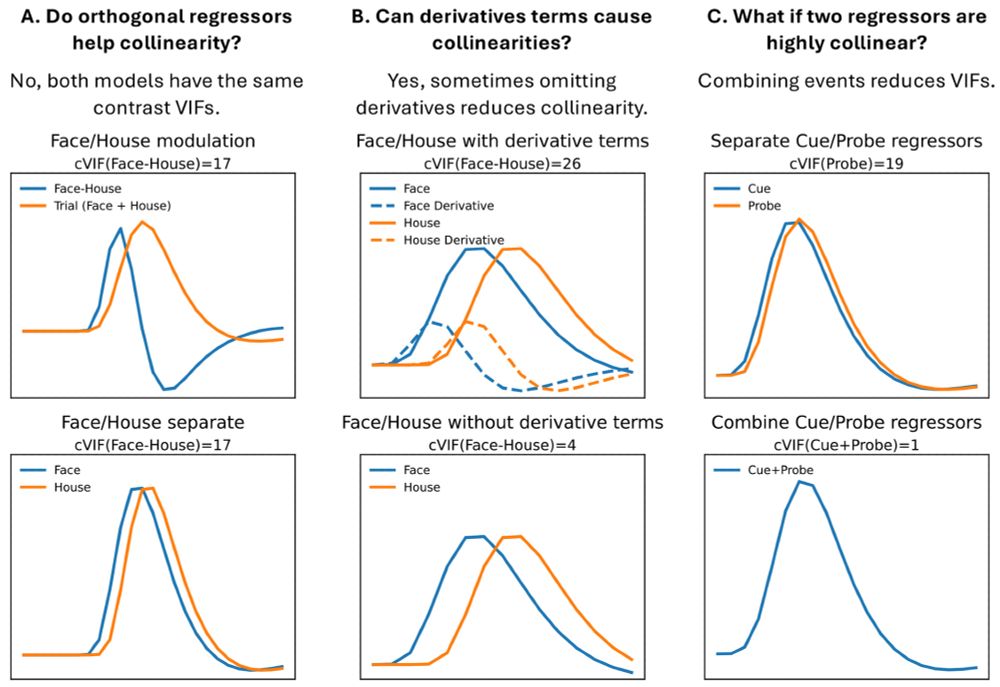
October 25, 2025 at 5:29 AM
New paper in Imaging Neuroscience by Jeanette A. Mumford, Russell A. Poldrack, et al:
Unintended bias in the pursuit of collinearity solutions in fMRI analysis
doi.org/10.1162/IMAG...
Unintended bias in the pursuit of collinearity solutions in fMRI analysis
doi.org/10.1162/IMAG...
Reposted by Heidi Jacobs
A noninvasive, CSF-specific MRI technique that enables detailed in vivo measurement of CSF mobility in humans, down to the level of perivascular spaces located around penetrating vessels
www.nature.com/articles/s41...
www.nature.com/articles/s41...

Region-specific drivers of CSF mobility measured with MRI in humans - Nature Neuroscience
Brain clearance mechanisms are challenging to visualize in humans. Using magnetic resonance imaging, the authors noninvasively mapped cerebrospinal fluid motion across the brain, showing region-specif...
www.nature.com
October 24, 2025 at 4:02 PM
A noninvasive, CSF-specific MRI technique that enables detailed in vivo measurement of CSF mobility in humans, down to the level of perivascular spaces located around penetrating vessels
www.nature.com/articles/s41...
www.nature.com/articles/s41...
Academic mentoring across generations: earlier this week, I heard my mentor commenting on writing and how to convey findings clearly, and realized that I now mentor in the exact same way. When my student received compliments for clarity in writing from a co-author, I was immensely proud & grateful.
October 23, 2025 at 2:32 AM
Academic mentoring across generations: earlier this week, I heard my mentor commenting on writing and how to convey findings clearly, and realized that I now mentor in the exact same way. When my student received compliments for clarity in writing from a co-author, I was immensely proud & grateful.
Reposted by Heidi Jacobs
This fundamental study uncovers how chronic stress drives overexcitation and degeneration of locus coeruleus neurons by triggering internalisation of α2A-adrenergic receptors, revealing a potential therapeutic target for anxiety and Alzheimer’s disease.
buff.ly/KzU4VnR
buff.ly/KzU4VnR

October 14, 2025 at 10:02 AM
This fundamental study uncovers how chronic stress drives overexcitation and degeneration of locus coeruleus neurons by triggering internalisation of α2A-adrenergic receptors, revealing a potential therapeutic target for anxiety and Alzheimer’s disease.
buff.ly/KzU4VnR
buff.ly/KzU4VnR
Reposted by Heidi Jacobs
In the amygdala, noradrenergic signaling in astrocytes could prime their response to nearby neurons that helps stabilize fear memories.
By @lauren-schneider.com
www.thetransmitter.org/memory/engra...
By @lauren-schneider.com
www.thetransmitter.org/memory/engra...

Engrams in amygdala lean on astrocytes to solidify memories
Disrupting the astrocyte-neuronal dynamic in mice destabilizes their memory of fear conditioning.
www.thetransmitter.org
October 22, 2025 at 9:23 PM
In the amygdala, noradrenergic signaling in astrocytes could prime their response to nearby neurons that helps stabilize fear memories.
By @lauren-schneider.com
www.thetransmitter.org/memory/engra...
By @lauren-schneider.com
www.thetransmitter.org/memory/engra...
Reposted by Heidi Jacobs
🚨New in Lancet Neurology: Autopsy study of aducanumab in #Alzheimer’s shows superficial cortical Aβ cleared, but deeper persists. ARIA showed inflammation+ microinfarcts in leptomeningeal/penetrating vessels. Some path is PET-invisible. @drneurochic.bsky.social
authors.elsevier.com/a/1lxn85FFzL...
authors.elsevier.com/a/1lxn85FFzL...

October 16, 2025 at 10:33 AM
🚨New in Lancet Neurology: Autopsy study of aducanumab in #Alzheimer’s shows superficial cortical Aβ cleared, but deeper persists. ARIA showed inflammation+ microinfarcts in leptomeningeal/penetrating vessels. Some path is PET-invisible. @drneurochic.bsky.social
authors.elsevier.com/a/1lxn85FFzL...
authors.elsevier.com/a/1lxn85FFzL...
Reposted by Heidi Jacobs
A bit belated, but here are some new papers! first, a conceptual framework for modelling extremes in neuroimaging data
onlinelibrary.wiley.com/doi/full/10....
Great work from the inimitable Charlotte Fraza!
onlinelibrary.wiley.com/doi/full/10....
Great work from the inimitable Charlotte Fraza!

Using Extreme Value Statistics to Reconceptualize Psychopathology as Extreme Deviations From a Normative Reference Model
Overview of our approach for extreme value statistics. First, we fit a normative model to imaging phenotypes, before employing a ‘peaks-over-threshold’ approach widely used in meteorology and finance...
onlinelibrary.wiley.com
October 16, 2025 at 3:00 PM
A bit belated, but here are some new papers! first, a conceptual framework for modelling extremes in neuroimaging data
onlinelibrary.wiley.com/doi/full/10....
Great work from the inimitable Charlotte Fraza!
onlinelibrary.wiley.com/doi/full/10....
Great work from the inimitable Charlotte Fraza!
Very grateful and honored to receive a 2025 Distinguished Investigator award and to be a member of the council of distinguished investigators of The Academy for Radiology & Biomedical Imaging Research @acadrad.bsky.social
www.acadrad.org/wp-content/u...
www.acadrad.org/wp-content/u...
www.acadrad.org
October 9, 2025 at 3:30 PM
Very grateful and honored to receive a 2025 Distinguished Investigator award and to be a member of the council of distinguished investigators of The Academy for Radiology & Biomedical Imaging Research @acadrad.bsky.social
www.acadrad.org/wp-content/u...
www.acadrad.org/wp-content/u...
Reposted by Heidi Jacobs
How prediction error drives memory updating: role of locus coeruleus–hippocampal interactions: Trends in Neurosciences www.cell.com/trends/neuro...

How prediction error drives memory updating: role of locus coeruleus–hippocampal interactions
The brain constantly generates predictions based on one’s knowledge of the world,
as captured in memory. When these predictions are in error, our knowledge base must
be revised to remain relevant. Her...
www.cell.com
October 4, 2025 at 3:17 PM
How prediction error drives memory updating: role of locus coeruleus–hippocampal interactions: Trends in Neurosciences www.cell.com/trends/neuro...
Reposted by Heidi Jacobs
Thrilled to share that our paper “Molecular hallmarks of excitatory and inhibitory neuronal resilience to Alzheimer’s disease” is now out in Molecular Neurodegeneration!
👉 link.springer.com/article/10.1...
#Alzheimer #Resilience #Neuroscience
👉 link.springer.com/article/10.1...
#Alzheimer #Resilience #Neuroscience

Molecular hallmarks of excitatory and inhibitory neuronal resilience to Alzheimer’s disease - Molecular Neurodegeneration
Background A significant proportion of individuals maintain cognition despite extensive Alzheimer’s disease (AD) pathology, known as cognitive resilience. Understanding the molecular mechanisms that protect these individuals could reveal therapeutic targets for AD. Methods This study defines molecular and cellular signatures of cognitive resilience by integrating bulk RNA and single-cell transcriptomic data with genetics across multiple brain regions. We analyzed data from the Religious Order Study and the Rush Memory and Aging Project (ROSMAP), including bulk RNA sequencing (n = 631 individuals) and multiregional single-nucleus RNA sequencing (n = 48 individuals). Subjects were categorized into AD, resilient, and control based on β-amyloid and tau pathology, and cognitive status. We identified and prioritized protected cell populations using whole-genome sequencing-derived genetic variants, transcriptomic profiling, and cellular composition. Results Transcriptomics and polygenic risk analysis position resilience as an intermediate AD state. Only GFAP and KLF4 expression distinguished resilience from controls at tissue level, whereas differential expression of genes involved in nucleic acid metabolism and signaling differentiated AD and resilient brains. At the cellular level, resilience was characterized by broad downregulation of LINGO1 expression and reorganization of chaperone pathways, specifically downregulation of Hsp90 and upregulation of Hsp40, Hsp70, and Hsp110 families in excitatory neurons. MEF2C, ATP8B1, and RELN emerged as key markers of resilient neurons. Excitatory neuronal subtypes in the entorhinal cortex (ATP8B+ and MEF2Chigh) exhibited unique resilience signaling through activation of neurotrophin (BDNF-NTRK2, modulated by LINGO1) and angiopoietin (ANGPT2-TEK) pathways. MEF2C+ inhibitory neurons were over-represented in resilient brains, and the expression of genes associated with rare genetic variants revealed vulnerable somatostatin (SST) cortical interneurons that survive in AD resilience. The maintenance of excitatory-inhibitory balance emerges as a key characteristic of resilience. Conclusions We have defined molecular and cellular hallmarks of cognitive resilience, an intermediate state in the AD continuum. Resilience mechanisms include preserved neuronal function, balanced network activity, and activation of neurotrophic survival signaling. Specific excitatory neuronal populations appear to play a central role in mediating cognitive resilience, while a subset of vulnerable interneurons likely provides compensation against AD-associated hyperexcitability. This study offers a framework to leverage natural protective mechanisms to mitigate neurodegeneration and preserve cognition in AD.
link.springer.com
October 1, 2025 at 7:45 PM
Thrilled to share that our paper “Molecular hallmarks of excitatory and inhibitory neuronal resilience to Alzheimer’s disease” is now out in Molecular Neurodegeneration!
👉 link.springer.com/article/10.1...
#Alzheimer #Resilience #Neuroscience
👉 link.springer.com/article/10.1...
#Alzheimer #Resilience #Neuroscience
Reposted by Heidi Jacobs
For #FluorescenceFriday✨ Exploring the beauty of the locus Coeruleus using IF staining: neurons🔵 surrounded by glowing astrocytes🟢 embracing delicate blood vessels🔴, alongside striking pTau signals💗. A vivid reminder of the cellular complexity shaping brain health and disease. #LC #Neuroscience

September 26, 2025 at 6:49 PM
For #FluorescenceFriday✨ Exploring the beauty of the locus Coeruleus using IF staining: neurons🔵 surrounded by glowing astrocytes🟢 embracing delicate blood vessels🔴, alongside striking pTau signals💗. A vivid reminder of the cellular complexity shaping brain health and disease. #LC #Neuroscience
Reposted by Heidi Jacobs
At #ICON? – Join us tomorrow to hear about novel measurement & manipulation approaches for neuromodulatory systems!
🗓️Sept 19,
🕚11:45 am
🏫Room Sé
#ICON2025 #CogNeuro #AcademicSky #LocusCoeruleus #neuroskyence
🗓️Sept 19,
🕚11:45 am
🏫Room Sé
#ICON2025 #CogNeuro #AcademicSky #LocusCoeruleus #neuroskyence

September 18, 2025 at 7:56 PM
At #ICON? – Join us tomorrow to hear about novel measurement & manipulation approaches for neuromodulatory systems!
🗓️Sept 19,
🕚11:45 am
🏫Room Sé
#ICON2025 #CogNeuro #AcademicSky #LocusCoeruleus #neuroskyence
🗓️Sept 19,
🕚11:45 am
🏫Room Sé
#ICON2025 #CogNeuro #AcademicSky #LocusCoeruleus #neuroskyence
Reposted by Heidi Jacobs
Shining the light on the Neuromodulatory Subcortical Systems PIA today! ✨ Explore their 2024-2025 activities and share your thoughts: istaart.alz.org/PIA-reports

September 15, 2025 at 12:28 PM
Shining the light on the Neuromodulatory Subcortical Systems PIA today! ✨ Explore their 2024-2025 activities and share your thoughts: istaart.alz.org/PIA-reports
Reposted by Heidi Jacobs
New paper from the lab. First author @mwelhaf.bsky.social, now in a TT position at North Carolina A&T. We wanted to know how environmental contexts and self-reported distractions impacted cognitive #EMA in older adults. mhealth.jmir.org/2025/1/e71578 1/n

Impacts of Environmental Distractions and Interruptions on Unsupervised Digital Cognitive Assessments in Older Adults: Cognitive Ecological Momentary Assessment Study
Background: Unsupervised cognitive assessments are becoming commonly used in studies of aging and neurodegenerative diseases. Because assessments are completed in everyday environments and without a p...
mhealth.jmir.org
September 13, 2025 at 1:55 PM
New paper from the lab. First author @mwelhaf.bsky.social, now in a TT position at North Carolina A&T. We wanted to know how environmental contexts and self-reported distractions impacted cognitive #EMA in older adults. mhealth.jmir.org/2025/1/e71578 1/n
Reposted by Heidi Jacobs
We showed previously that chemogenetic activation of the LC rescues spatial reversal learning in the TgF344-AD rat. New paper follows up and reports that optogenetic stimulation of LC terminals in CA1 also rescues cognitive deficits in 3xTg mouse model of AD. link.springer.com/article/10.1...

Photostimulation of locus coeruleus CA1 catecholaminergic terminals reversed Spatial memory impairment in an alzheimer’s disease mouse model - Psychopharmacology
Rationale One of the earliest changes associated with Alzheimer’s disease (AD) is the loss of catecholaminergic terminals in the cortex and hippocampus originating from the Locus Coeruleus (LC). This ...
link.springer.com
September 12, 2025 at 6:50 PM
We showed previously that chemogenetic activation of the LC rescues spatial reversal learning in the TgF344-AD rat. New paper follows up and reports that optogenetic stimulation of LC terminals in CA1 also rescues cognitive deficits in 3xTg mouse model of AD. link.springer.com/article/10.1...
Reposted by Heidi Jacobs
Do you ever wish you could just use python to pull together the files and code for running FSL's randomise? Me too! I made this: github.com/jmumford/ran... It will even replace the numbers in the file outputs with contrast names of your choosing (and replace corrp with 1minusp).

GitHub - jmumford/randomise-prep: Generate design matrices, contrasts, and scripts to set up FSL randomise analyses.
Generate design matrices, contrasts, and scripts to set up FSL randomise analyses. - jmumford/randomise-prep
github.com
September 12, 2025 at 1:41 AM
Do you ever wish you could just use python to pull together the files and code for running FSL's randomise? Me too! I made this: github.com/jmumford/ran... It will even replace the numbers in the file outputs with contrast names of your choosing (and replace corrp with 1minusp).
Reposted by Heidi Jacobs
Inter-individual variability of neurotransmitter receptor and transporter density in the human brain | bioRxiv www.biorxiv.org/content/10.1...
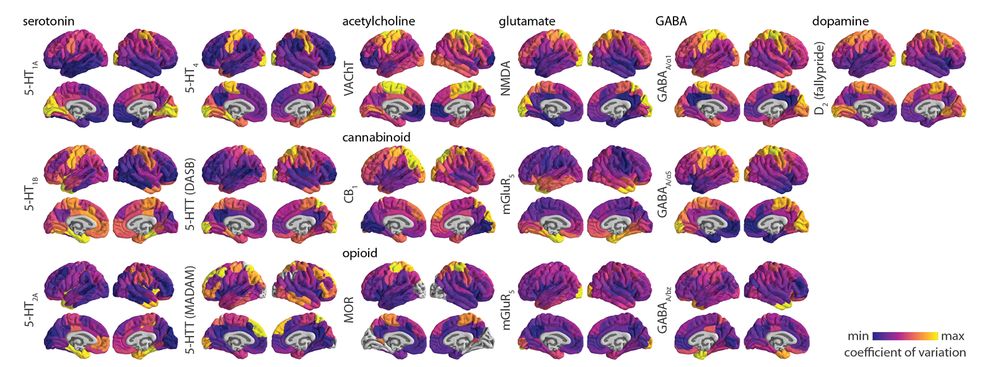
September 11, 2025 at 1:47 AM
Inter-individual variability of neurotransmitter receptor and transporter density in the human brain | bioRxiv www.biorxiv.org/content/10.1...
Reposted by Heidi Jacobs
Age-Related Changes in Curiosity: The Influence of Locus Coeruleus on Information-Seeking Behavior https://www.biorxiv.org/content/10.1101/2025.09.04.674248v1
September 5, 2025 at 8:15 AM
Age-Related Changes in Curiosity: The Influence of Locus Coeruleus on Information-Seeking Behavior https://www.biorxiv.org/content/10.1101/2025.09.04.674248v1
Reposted by Heidi Jacobs
#ThisWeekInNPP
Early life stress profoundly impacts the 🧠 & can result in negative affective behaviors well into adulthood
Here, maternal separation stress produced dysregulated noradrenergic activity in the locus coeruleus (LC) across the lifespan, disrupting LC regulation of coping strategies
Early life stress profoundly impacts the 🧠 & can result in negative affective behaviors well into adulthood
Here, maternal separation stress produced dysregulated noradrenergic activity in the locus coeruleus (LC) across the lifespan, disrupting LC regulation of coping strategies
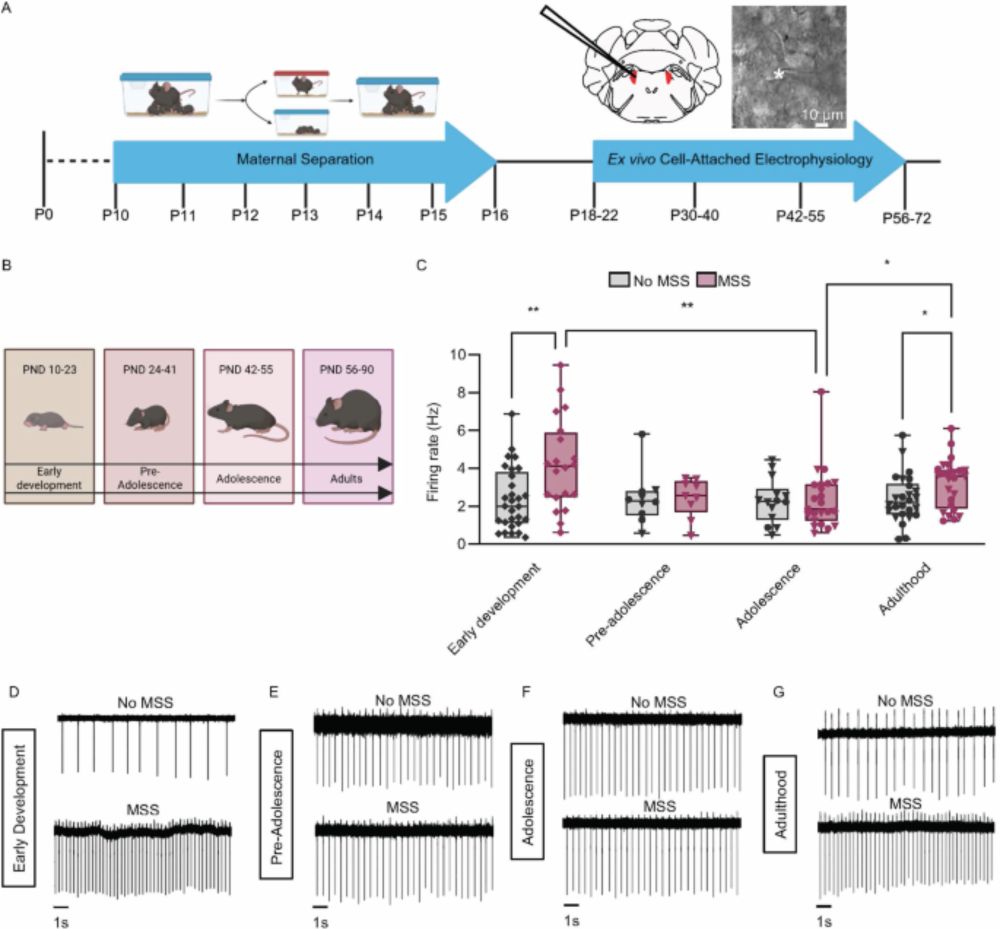
Maternal separation disrupts noradrenergic control of adult coping behaviors - Neuropsychopharmacology
Neuropsychopharmacology - Maternal separation disrupts noradrenergic control of adult coping behaviors
www.nature.com
September 9, 2025 at 5:08 PM
#ThisWeekInNPP
Early life stress profoundly impacts the 🧠 & can result in negative affective behaviors well into adulthood
Here, maternal separation stress produced dysregulated noradrenergic activity in the locus coeruleus (LC) across the lifespan, disrupting LC regulation of coping strategies
Early life stress profoundly impacts the 🧠 & can result in negative affective behaviors well into adulthood
Here, maternal separation stress produced dysregulated noradrenergic activity in the locus coeruleus (LC) across the lifespan, disrupting LC regulation of coping strategies

